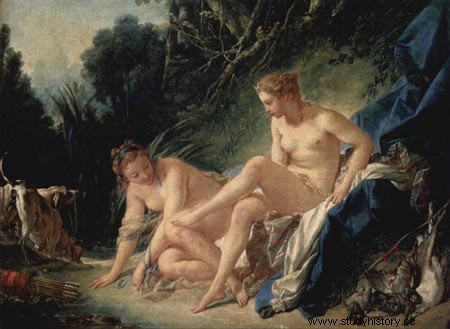In Greek mythology, Artemis is the goddess of the hunt and of the Moon (by analogy with Apollo, who is the god of the Sun). In Roman mythology, she is called Diana.
-

- “Diana of Versailles”
- statue of Artemis hunting, accompanied by a doe. Imperial period Roman copy (1st-2nd century AD) of a Greek bronze original attributed to the Athenian sculptor Leochares (4th century BC)
Public domain I, the author of this work, hereby release it into the public domain. This applies worldwide.
In case this is not legally possible:
I grant anyone the right to use this work for any purpose, without any conditions, unless such conditions are required by law.
She is the daughter of Zeus and Leto and the twin sister of Apollo (or simply her sister, according to the Homeric hymn dedicated to her), with whom she shares many common traits.
Divinity of margins
Artemis makes the country of the Hyperboreans her main residence (Pindare, Third Ode, 26) where she reigns as mistress of wild nature and animals. "Let all the mountains be mine" she declares in the hymn of Callimachus of Cyrene. She also roams in the agroi, wastelands, uncultivated and little frequented. As Jean-Pierre Vernant points out, it “has its place by the sea, in coastal areas where the limits between land and water are indecisive”. Always located on the border between the civilized world and the savage world, Artemis the huntress is also a kourotrophós (Diodorus of Sicily, V, 73), who presides over the initiation of the young of men and animals and accompanies them until 'on the threshold of adult life.
-

- Diana the Huntress, by Auguste Renoir (1867)
- The work of art depicted in this image and the reproduction thereof are in the public domain worldwide. The reproduction is part of a collection of reproductions compiled by The Yorck Project. The entire collection is copyrighted by The York Project and licensed under the GNU Free Documentation License.
Armed with a bow and arrows offered by the Cyclops (Callimaque, Hymns, III) Artemis assists her brother Apollo in his fight against the snake Python as well as in gigantomachy. During the Trojan War, she is also on the side of the Trojans. Like him, she slays the Niobids with her arrows. She helps him get revenge on Coronis and Tityos. In general, she sends sudden death on women, while Apollo takes care of men. In The Iliad, Hera describes her as "a lioness for women". They sing to him, as to Apollo, the pean.
Huntress with the golden bow
Runner of the woods, rebellious and proud savage, Artémis belongs above all to the wild world. Alone among the gods, with the exception of Dionysus, she is constantly surrounded by a troop of wild animals, hence her epiclesis of Hêgêmónê, “the Conductress”. She is also at the head of a troop of nymphs (20 nymphs of Mount Amnios, according to Callimachus) and young mortals, which she leads through the forests. The Iliad speaks of her as "the rustic Artemis (...), the lady of the beasts" (XXI, 470).
Nicknamed the "Noisy" (Keladeinế), she leads her pack and pushes them with her voice. Artemis indeed has the double face of the companion of wild animals, and of the huntress. The doe symbolizes his ambivalence well:the beast is his favorite companion, and many representations show it at his side. Nevertheless, Artemis is also the one who is reputed to pursue stags and hinds with her arrows, even if few texts attest to this.
The Sagittarius goddess is finally called by Homer Artemis khrysêlakatos, "with the golden bow". In Homer, the arc is said to be bios, which is close to bios, "life". This is why Artemis, also called "the radiant one", is also the one who guides the lost, the strangers, or the slaves on the run in the heart of the night. Also Artemis bears in Latin the name of Trivia, "she who lights the road at the crossroads of life".
-

- Diana in the bath, by François Boucher (1742)
- The work of art depicted in this image and the reproduction thereof are in the public domain worldwide. The reproduction is part of a collection of reproductions compiled by The Yorck Project. The entire collection is copyrighted by The York Project and licensed under the GNU Free Documentation License.
Ambiguous Goddess
Like Athena and Hestia, Artemis is a "virgin" goddess, improperly considered by mythocritics until the 19th century as "chaste", until Jean-Pierre Vernant sheds more light on the adjectives attached to her name. Artemis is parthenos, the virgin who takes care of the fire, or, as Plutarch reports, the one who abstains from all sexual intercourse with men. She severely punishes the men who try to seduce her:"sad weddings, those sought by Otos and Oarion" (Callimaque, 3, 264-265). When Actéon surprises her by chance in her bath, she transforms him into a stag and has him torn apart by her own dogs. She also monitors the chastity of her companions:she shoots an arrow at Callisto, daughter of Lycaon, for having had sexual intercourse with Zeus. It should be noted that Zeus achieved his ends with Callisto because he had taken on the appearance of Artemis, an element that reveals the ambiguity of the relationship between Artemis and Callisto.
Epithets, attributes and shrines
 Its attributes:the bow, the crescent Moon;
Its attributes:the bow, the crescent Moon;
 His favorite animals:the doe;
His favorite animals:the doe;
 Its sanctuaries:Temple of Artemis in Ephesus, one of the seven wonders of the world; the Stymphalian Lake in Arcadia; Sanctuary of Olbia (Hyères); Sanctuary of Artemis Orthia (Sparta).
Its sanctuaries:Temple of Artemis in Ephesus, one of the seven wonders of the world; the Stymphalian Lake in Arcadia; Sanctuary of Olbia (Hyères); Sanctuary of Artemis Orthia (Sparta).
